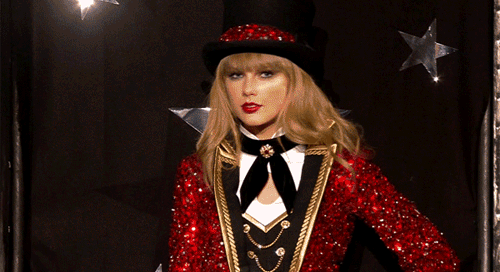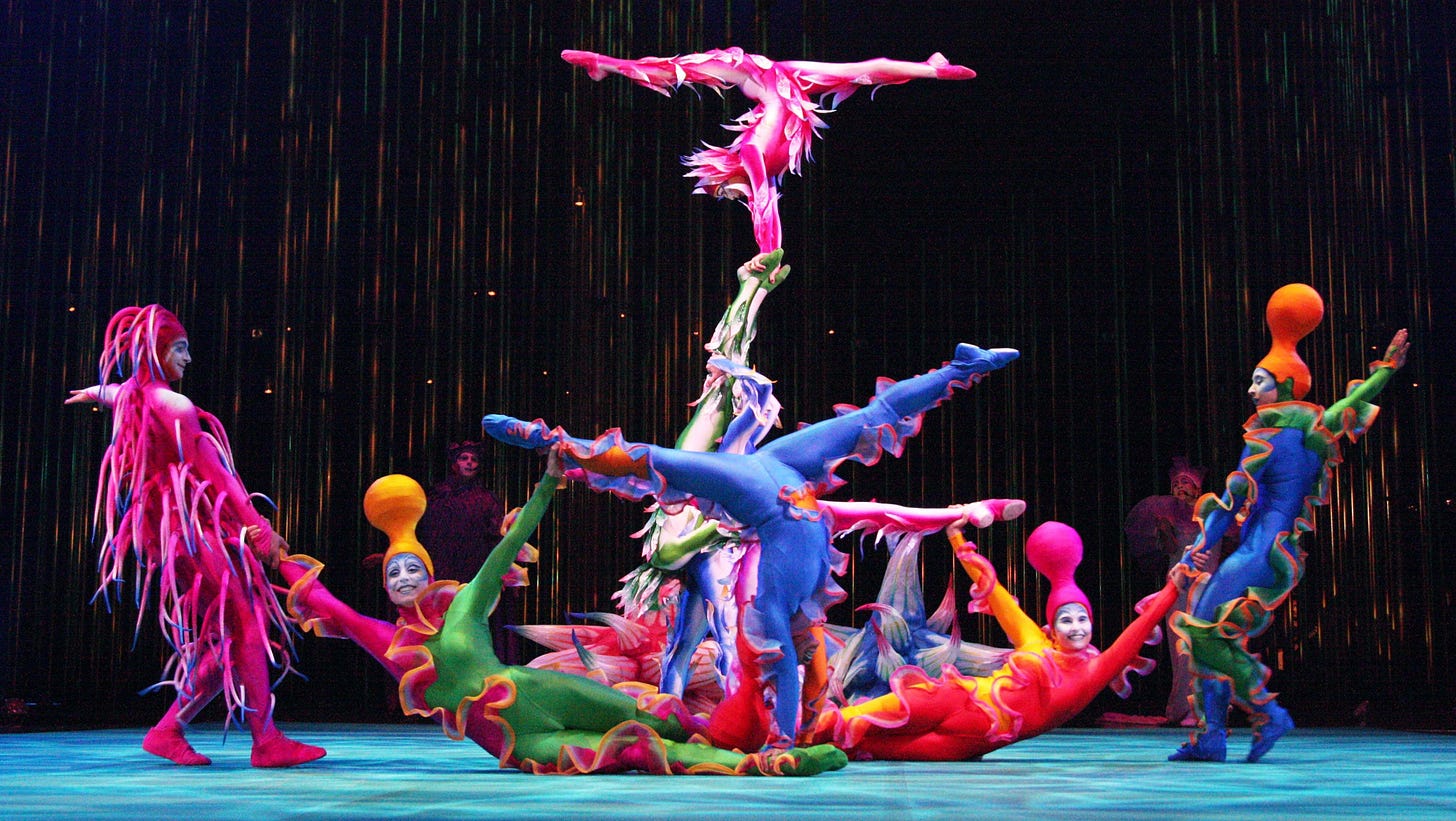The Greatest Showwoman: Taylor Swift's Circus Symbolism
This week's episode on circus imagery in Taylor Swift's music is available now!
The clown emoji 🤡 is a common sight in Swiftie communities, but instead of thinking about how we are wrong 99.9999% of the time as fans, this week we are diving into how Taylor uses circus imagery in her music! From lyrics about tightropes in “Say Don’t Go” to illusionists in “So It Goes…” and a whole collection of circus imagery in “Who’s Afraid of Little Old Me,” we had so much fun thinking about why these metaphors are so meaningful in this week’s episode. Check it out!
🎧 Listen above and ⬇️ scroll below to read Jenn’s extra credit about the darker side of circuses (and maybe some thoughts on how to balance being aware but still enjoying life)!
✨ We want to hear from you! ✨
Whether you listen weekly, read occasionally, or just joined us—this quick survey helps us understand who’s here and how to make the podcast + newsletter even better. It takes 5 minutes, and we’d be so grateful for your input.
📜 This Week’s Extra Credit by Jenn
In this week’s episode, we had a blast diving into the circus imagery and metaphors that weave through Taylor's discography. From the balancing act in "Say Don’t Go" to the circus life in “Who’s Afraid of Little Old Me,” our favorite songwriter has long been fascinated with the spectacular, the performative, and yes, sometimes the exploitative nature of entertainment.
But as we peel back the curtain of circus history, there's much more beneath the surface than cotton candy and acrobatics. While Taylor uses circus imagery to explore fame, performance, and spectacle, the actual history of circuses carries centuries of complicated, often troubling narratives that deserve our attention.
So grab your metaphorical ticket, and let's venture beyond the main tent into the shadows of circus history that rarely make it into our collective nostalgia.
Step Right Up: The Birth of Modern Exploitation
While we talked about the history of the circus a bit in this episode, let’s get into it a bit more. According to the Encyclopedia Britannica, the modern circus as we know it emerged in the late 18th century, but quickly evolved from simple equestrian shows into something far more problematic. Philip Astley, often credited as the "father of the modern circus," created circular riding displays in London in 1768 that focused primarily on horsemanship. But as competition grew, so did the pressure to present more "exotic" and sensational acts. (Side note: When reading anything in history, “exotic” is almost always a red flag for racism and colonialism.)
By the 19th century, circuses became vehicles for displaying "human curiosities," which basically meant individuals with physical differences or disabilities who were marketed as “freaks” and “oddities.” The dehumanization inherent in these side shows was deeply problematic and furthered the idea that white, heterosexual, Christian men were (and still are) considered “normal” and everyone else is “other.”
We discussed the concept of “othering” in our episode this week, but it’s worth revisiting for just a moment. Taylor often uses the idea of a circus to metaphorically describe being watched, being the spectacle. It’s an apt metaphor; however, in real circuses throughout history, these individuals weren't choosing stardom, they were often coerced into it. When Taylor sings about the fishbowl of fame, she's touching on a fraction of what these exhibited individuals experienced, with none of the compensation or agency that modern celebrities possess.
The Colonial Menagerie: Exotic Animals, Exotic People
As European powers expanded their colonial reach in the 19th century, circuses became showcases for imperial conquest. Animals and people from colonized territories were captured, transported, and displayed as living trophies of Western domination over "savage" lands.
P.T. Barnum, whose name still adorns circus productions today, was particularly notorious for this practice. His American Museum and later his circus featured what he called "ethnological exhibits" of indigenous people from various parts of the world. These individuals were presented not as fellow humans with rich cultures, but as specimens of "primitive" humanity, often forced to perform stereotypical behaviors for white audiences.
The parallels to animal exhibits were intentional and horrifying. People from Africa, Asia, and indigenous communities were displayed alongside exotic animals, both presented as curiosities for the paying public. This dehumanization reinforced racist ideologies that justified colonial expansion and oppression.
This context adds layers to Swift's circus metaphors about performing for audiences. While she's describing the voluntary (if pressured) performance of celebrities, these historical circus "performers" were, in fact, captives in a system that profited from their otherness.
Undoing the Spectacle: Reform, Resistance, and Reckoning
By the early 20th century, growing resistance to exploitative circus practices began to emerge. Disability rights advocates challenged "freak shows," animal welfare organizations questioned the treatment of performing animals, and civil rights movements pushed against racist exhibitions and hiring practices.
Circus performers themselves were often at the forefront of these changes. Many formed unions, advocated for better working conditions, and pushed back against the most exploitative aspects of the industry. Organizations like the Circus Fans Association of America eventually began advocating for more ethical circus practices.
More recently, companies like Cirque du Soleil have reimagined the circus without animals and with greater emphasis on showcasing voluntary human artistry rather than exploitation. The closure of Ringling Bros. and Barnum & Bailey Circus in 2017 marked the end of an era, one that carried both beloved traditions and troubling legacies.
Conclusion: Beyond the Big Top
The evolution of circuses is, in my opinion, inspiring. While calling out exploitative, problematic things in culture is absolutely important, the world of circuses presents at least somewhat of a roadmap on how to embrace the good (showmanship! incredible talent!) while disowning and disavowing the bad. It’s the story of advocates who made actual change from both the inside and the outside, which tells us that it’s possible!
While fame is not even close to the same levels of horror that early circus performers experienced, it also has some pretty bad side effects. We’ve talked about this many times on the podcast, but that’s partly why we actively avoid the world of gossip when it comes to Taylor. Navigating the nuanced line of enjoying art without exploiting the artist is a challenge in a world where personality equates brand. But separating that out is a skill we practice every time we record!
So next time you hear Taylor reference carnivals, circuses, and performing for crowds, maybe you'll think a little differently about what it means to be the spectacle versus what it means to be the spectator, and who gets to choose which role they play.
Until next week, keep your clown makeup fresh (reputation tv is coming literally any day now, I swear) and your critical thinking fresher!





